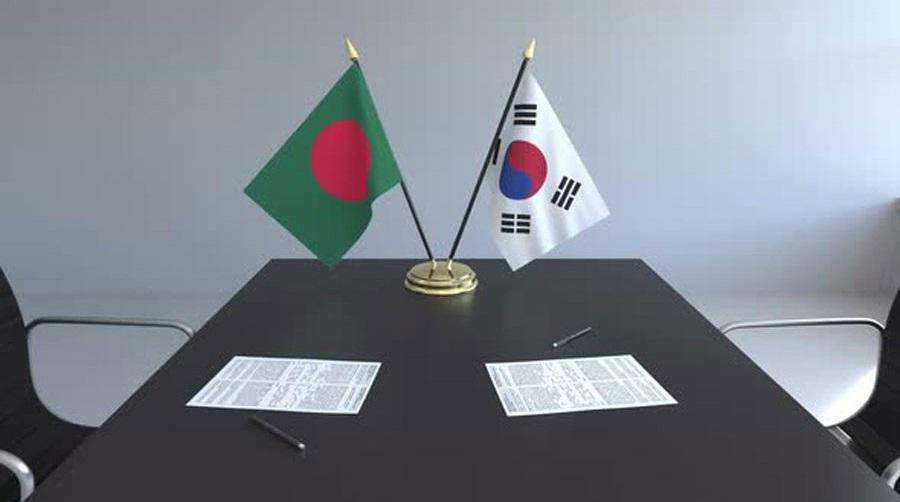Bangladesh should groom its manpower properly to tap the labour market of South Korea as the Northeast Asian country requires an increasing number of expat workers against the backdrop of declining population growth, sources in Dhaka and Seoul said.
Bangladesh exported a total of 4,996 workers to South Korea in 2023 and 1,425 workers during January-June period of the current calendar year 2024, according to Bureau of Manpower, Employment and Training (BMET).
South Korean President Yoon Suk Yeol in 2023 in a meeting said that the government announced its intention to address the pressing industrial labour shortage by increasing the influx of foreign workers to an unprecedented level.
Plans are set to expand 2024’s foreign workforce intake to over 120,000 workers while facilitating continuity for skilled foreign workers to ensure that they can work in South Korea without repeated departures and re-entries.
Meanwhile, South Korea’s fertility rate – already the lowest in the world – has fallen yet again, amid fears of “national extinction”, an ongoing debate about how to reverse the trend, and how the country’s work culture and gender relations could be to blame.
Data from Statistics Korea showed recently that there had been an 8-percent decline in the country’s fertility rate in 2023 compared with the previous year, while experts have said that the country’s population of 51 million may halve by 2100 based on current rates.
South Korea’s government has been spending billions of dollars to try and reverse the trend, as the population continues to shrink.
The average number of babies a South Korean woman is expected to give birth to during her life fell to 0.72 from 0.78 in 2022, and previous projections estimate that this will fall even further, to 0.68 in 2024.
These levels are far below the 2.1 children needed to maintain a country’s population at its current level.
Meanwhile, Bangladesh can export a record number of 10,000-20,000 workers to South Korea next year as the 10the largest economy of the world has decided to expand the number of recruitment by several times to help companies and industries battling the crunch of blue workers, diplomats, policy-makers and manpower exporters said.
Earlier, the South Korean government planned to receive 10,000 Bangladeshi expatriate workers this year, said a south Korean diplomat. Former Expatriates’ Welfare and Overseas Employment Secretary Ahmed Munirus Saleheen said that the government of Bangladesh would leave no stone unturned to cash in on the new plan of the South Korean government.
He said the government set up a number of training institutes to groom manpower catering to the market of South Korea.
The perks of workers in the South Korean market are lucrative compared to the Gulf countries, said a former Bangladesh diplomat in Seoul while talking to this correspondent, adding that grooming of Bangladeshi workers in South Korean language and culture is important to compete with workers of Nepal, Thailand, Vietnam and Cambodia.
She said learning language and to be imbued with ROK culture is important as the South Korean entrepreneurs and industrialists desire that expat workers should have a sound hold on the matter.
Meanwhile, a BAIRA leader while talking to this correspondent said that proper policy support and guidance, strict government monitoring and successful and effective diplomacy can give a boost to the export of manpower.
He also said the prospect of manpower export to developed countries will be increased in the coming days as the population growth in the rich countries has dropped leading to a crunch of workers.
While talking to this correspondent, a high official of the BMET said the government of Bangladesh has set up a crash plan to train workers in different parts of the country to cater to the growing demands in the developed countries.
South Korean Justice Minister Han Dong-hoon on June 28, 2023 said that South Korea will boost its annual quota of visas for skilled workers to more than 30,000 this year from just 2,000 a year ago, to help companies battling a staff crunch.
With younger South Koreans reluctant to take up blue-collar jobs, the industrial and farming sectors of Asia’s fourth-largest economy are struggling to fill vacancies.
Meanwhile, the number of foreigners who came to South Korea to find jobs last year was the second highest since data was first tracked in 2000, according to Korea JoongAng daily, a Korean newspaper.
This was mainly due to an increase in eligible potential job seekers due to the relaxation of visa regulations, according to Statistics Korea recently
A total of 173,000 people — 36 percent of the 480,000 foreigners who came to Korea last year — came for employment reasons, according to the statistics agency's data. This was up 25.5 percent from the 138,000 people who came in 2022, and was the largest figure recorded in 15 years since the 176,000 in 2008.
Statistics Korea said the influx was mainly driven by policy changes such as those that attracted expatriates, the quota increase for E-9 visas and the expansion of the Employment Permit System (EPS), which is designed to help small- and medium-sized companies legally hire foreign workers.
The number of E-9 visa holders who came to Korea was up 4 percent, or 3,000 people more, in 2023 compared to 2022. Notably, there was a significant on-year jump in holders of the E-7 visa, which is required for personnel employed for professional positions: up 206.6 percent from 4,000 in 2022 to 11,000 in 2023.
The Ministry of Justice increased the annual quota for E-7-4 visas from 2,000 to 35,000 in 2022, and the government plans to bring in a record 165,000 nonprofessional migrants under the EPS this year.
The net migration rate, meanwhile, was 161,000, falling from the record-high 168,000 posted in 2022. There was a net inflow of 121,000 people in 2023, an increase of 3,300 from 2022. More foreigners left Korea, up 11.4 percent on year, but the amount coming in offset those departing at an increased rate of 15.2 percent.
The number of foreigners who came for studies or training, however, dropped on year from 89,000 people in 2022 to 83,000 in 2023.
Over the recent years, the government and private sector have stepped up efforts to bring in more workers from abroad to offset the increasingly dwindling and aging population, aggravated by Korea’s plummeting birthrate.
Policies implemented in 2024 or planned for next year include changes to the categorization of visa applications as well as a broadening of employment opportunities for foreign students in nonprofessional sectors and an extension of the duration of job-seeking visas.
The Yoon Suk Yeol administration on July 3 pledged to more than double the number of overseas professional workers in Korea from 72,000 as of last year to 150,000 by 2035 as part of the government’s multiyear plan to bolster economic growth. Plans include a change in the visa system, enabling foreigners to work in the domestic labor and child care sectors.
Despite the amendment to immigration policies, experts and activists have cautioned that more broad and long-term improvements are needed, especially in social reception, safety measures and comprehensive policies that will retain the foreign workers.








.svg)


.jpg)